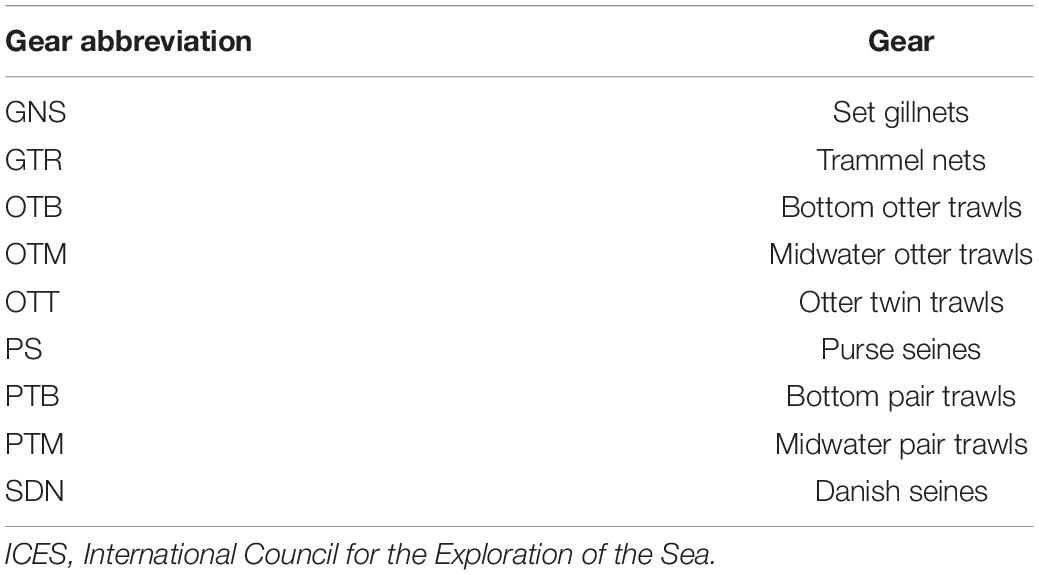- 1Observatoire Pelagis, UMS 3462-Université de La Rochelle-CNRS, La Rochelle, France
- 2ADERA, Pessac, France
- 3Centre d’Études Biologiques de Chizé-La Rochelle, UMR 7372-Université de La Rochelle-CNRS, La Rochelle, France
- 4Météo-France, DirOP/MAR, Toulouse, France
The first Unusual Mortality Event (UME) related to fishing activity along the Atlantic coast recorded by the French Stranding Network was in 1989: 697 small delphinids, mostly common dolphins, washed ashore, most of them with evidence of having been bycaught. Since then, UMEs of common dolphins have been observed nearly every year in the Bay of Biscay; unprecedented records were broken every year since 2016. The low and unequally distributed observation efforts aboard fishing vessels in the Bay of Biscay, as well as the lack of data on foreign fisheries necessitated the use of complementary data (such as stranding data) to elucidate the involvement of fisheries in dolphin bycatch. The aim of this work was to identify positive spatial and temporal correlations between the likely origins of bycaught stranded common dolphins (estimated from a mechanistic drift model) and fishing effort statistics inferred from Vessel Monitoring System (VMS) data on vessels >12 m long. Fisheries whose effort correlated positively with dolphin mortality areas after 2016 included French midwater trawlers, French Danish seiners, French gillnetters, French trammel netters, Spanish bottom trawlers, and Spanish gillnetters. For the French fleet only, logbook declarations, sales, and surveys carried out by Ifremer were integrated into fishing effort data. Six fleets were active in common dolphin bycatch areas at least twice between 2016 and 2019: gillnetters fishing hake, trammel netters fishing anglerfish, bottom pair trawlers fishing hake, midwater pair trawlers fishing sea bass and hake, and Danish seiners fishing whiting. Except for changes in hake landings in some fisheries, there were no notable changes in total fishing effort practice (gear or target species) based on the data required by the ICES and Council of the European Union that could explain the large increase in stranded common dolphins recorded along the French Atlantic coast after 2016. Small scale or unrecorded changes could have modified interactions between common dolphins and fisheries, but could not be detected through mandatory data-calls. The recent increase in strandings of bycaught common dolphins could have been caused by changes in their distribution and/or ecology, or changes in fishery practices that were undetectable through available data.
Introduction
The first multiple stranding event along the French Atlantic coast was recorded in winter 1989: 697 delphinids, mostly common dolphins, washed ashore, most of them presenting evidence of having been bycaught (Figure 1). Since then, severe mortality events of common dolphins have been recorded almost every year in the Bay of Biscay. Multiple stranding events, or “Unusual Mortality Events” (UMEs), are events in which a high number of strandings occur in a limited area with a common cause of death. The threshold was set at 30 cetaceans over 10 consecutive days recorded along a distance of up to 200 km of coastline in the Bay of Biscay (Peltier et al., 2014).
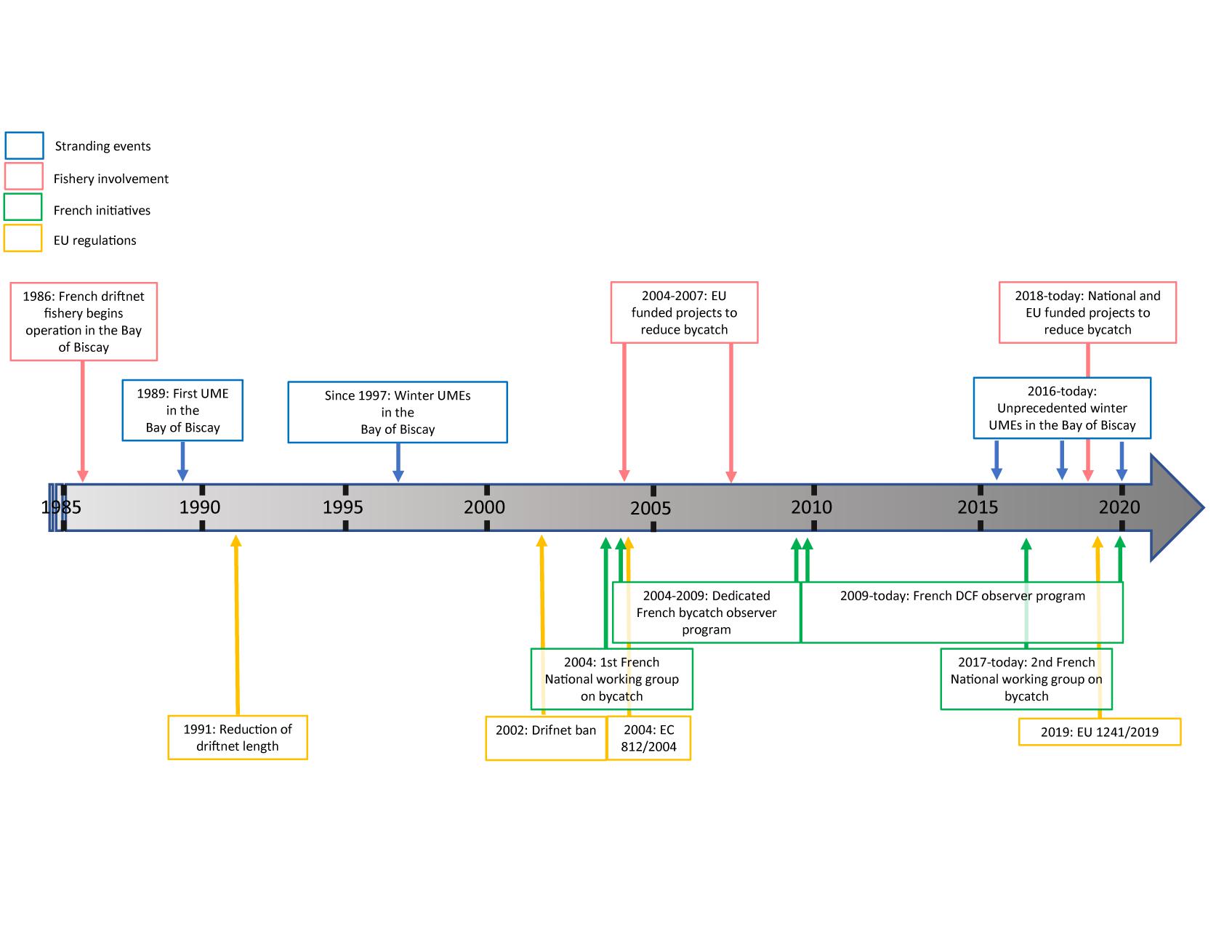
Figure 1. Main historical events in common dolphin bycatch management in the Bay of Biscay. DCF, Data Collection Framework; EC, European Commission; UME, unusual mortality event.
French driftnet fisheries, fishing for albacore tuna, began operating in the eastern North Atlantic in the mid-eighties (Northridge, 1991). This fishery operated between June and late September, more than 200 NM off the coast of the Bay of Biscay. The fleet had as many as 64 vessels in 1994, with nets up to 12 km long (average 7 km) (Antoine et al., 1997). Under NGO pressure, this fishery was subjected to a high degree of scrutiny: at-sea monitoring suggested total bycatch estimates of 400 dolphins per year, including both striped and common dolphins (Stenella coeruleoalba and Delphinus delphis). High levels of strandings reported in the Bay of Biscay in winter and the increase of driftnet fishing effort in summer were two independent processes that were erroneously confused in the media and public opinion. This likely influenced the Council of the European Union’s decision to reduce driftnet length in the Bay of Biscay to 2.5 km in 1991, and in 1997 to announce a ban of the fishery from January 1, 2002 (Council of the European Union, 1998).
Despite the driftnet ban, continued common dolphin UMEs in the winter led to the creation of a national working group on cetacean bycatch in 2004. This group was made up of scientists, representatives of the fishing industry, officers of the Ministry in charge of the Environment and the Ministry in charge of Fisheries. EU funded projects were carried out in order to estimate bycatch numbers, to explore the circumstances most associated with dolphin captures, and to test technological developments (acoustic repellents, or pingers, and excluder devices) that would reduce bycatch by midwater pair trawlers—considered at that time to have been responsible for the majority of cetacean bycatch (Northridge et al., 2006; NECESSITY Report, 2008). The dolphin bycatch issue lost salience in France in the late 2000s, probably due to the relative decrease in strandings recorded along the Atlantic coast, and the dedicated national working group was disbanded.
In 2004, under the Common Fishery Policy (CFP), European Commission (EC) Regulation no. 812/2004 (Council of the European Union, 2004) framed the monitoring of cetacean bycatch through compulsory on-board observers and the mandatory use of pingers on nets when fishing in latitudes north of 48°N. Member States were required to design and implement monitoring schemes for the incidental capture of cetaceans in selected fisheries and on fishing vessels with an overall length ≥15 m. By selecting focal fisheries for the implementation of on-board monitoring programs while excluding others, the EC Regulation 812/2004 precluded any possibility of providing a synoptic view of cetacean bycatch in EU fisheries. An observer program dedicated to marine mammal bycatch was implemented in France from 2005 until 2009, and was then merged with an at-sea observer program required by the European Commission under the Data Collection Framework (DCF; Council of the European Union, 2008). Designed to collect information on commercial catch, this revised observer program was no longer dedicated to cetacean bycatch and was thus less likely to assess the extent and magnitude of the issue. Within the framework of the DCF, fishing operations are classified into métiers according to their target species, gear used, fishing season and fishing area (Deporte et al., 2012). Of these métiers, those considered to pose the greatest risk of bycatch are generally under-sampled by general observer programs, leading to an underestimation of bycatch (ICES, 2020a). In 2014 in United Kingdom waters, comparisons between observer programs dedicated to bycatch and DCF observers highlighted an underestimation of fisheries’ impact on dolphins in non-dedicated programs (ICES, 2016). Two main biases were identified in non-dedicated fishery bycatch observation programs with low enforcement: (1) the deployment effect that results from skippers’ discretion to accept an observer on board, which produces non-random sampling and non-representative data and (2) the observer effect, i.e., a change in fishing practices when an observer is present, which also results in the collection of non-representative data (Benoît and Allard, 2009; Faunce and Barbeaux, 2011; Amandè et al., 2012; Murphy et al., 2019). In 2019, EC Regulation 812/2004 was repealed and replaced by the Technical Conservation Measures, EU Regulation 1241/2019 (Council of the European Union, 2019).
Since 2016, strandings of small cetaceans with evidence of bycatch occurred in unprecedented numbers along the Bay of Biscay coast, breaking annual records (Dars et al., 2019). During the winter of 2019 (January–April), 1,200 strandings of small cetaceans were recorded by the French Stranding Network (Réseau National Échouages), 1,089 of which were along the French Atlantic coast.1 Between 5,000 and 10,000 bycaught common dolphins were estimated in French Atlantic waters each year from 2016 to 2018 (ICES, 2020b; Peltier et al., 2020). Being one of the most abundant species in the North-East Atlantic (Hammond et al., 2017; Laran et al., 2017), common dolphins are among the most vulnerable to being caught in fishing gear (De Boer et al., 2008; Fernández-Contreras et al., 2010; Peltier et al., 2016; ICES, 2020b).
In 2017, a new national working group, comprising the same actors as in 2004, was set up with similar terms of reference: (1) improve knowledge of cetacean bycatch in the Bay of Biscay, (2) develop mitigation strategies to reduce bycatch, and (3) involve fishermen to raise awareness of the bycatch issue.
Today, in addition to Regulation 2019/1241 that set the obligation to “minimize, and where possible, eliminate” bycatch, various regulations frame the Member States’ obligations in term of bycatch mitigation. The objectives of the Common Fisheries Policy (Regulation 1380/2013, 2013) include implementation of “the ecosystem-based approach to fisheries management so as to ensure that negative impacts of fishing activities on the marine ecosystem are minimized” (Regulation 1380/2013, 2013). The Habitat Directive (Directive 92/43/EEC) requires Member States to establish protection measures to prohibit “all forms of deliberate capture or killing of specimens of these species in the wild.” The Good Environmental Status (Commission Decision 2017/848) required by the Marine Strategy Framework Directive (Directive 2008/56/EC) aims to ensure “the mortality rate per species from incidental bycatch is below levels which threaten the species, such that its long-term viability is ensured” and “the population abundance of the species is not adversely affected due to anthropogenic pressures, such that its long-term viability is ensured.”
Faced with the hurdles of enforcing efficient at-sea monitoring of the impact of fisheries on cetaceans, the use of complementary data was sought (IWC, 2016; ICES, 2017; Murphy et al., 2019). Stranding records are an important source of information on marine mammals, and can provide critical information to estimate a minimum level of bycatch across fisheries (Lopez et al., 2003; Leeney et al., 2008; Adimey et al., 2014). Methodological developments have allowed us to infer the likely origin of stranded carcasses using drift modeling (Peltier and Ridoux, 2015). Drift modeling, along with a better understanding of drift conditions, observation pressure and carcass floatation (Hart et al., 2006; Peltier et al., 2012; Authier et al., 2014; Moore et al., 2020), has broadened the use of stranding data for quantitative approaches (Peltier et al., 2016).
Since strandings can be used to model the likely mortality areas of small cetaceans, the possibility of identifying the potential fisheries involved has become a prominent topic of debate among scientists, stakeholders, NGOs and the fishing industry. The low coverage of non-dedicated observer programs in France has meant that the collected data could not be used to identify fisheries posing the greatest risk of bycatch. Therefore, a new methodology relying on independent data provided by strandings was developed to detect positive spatial correlations between common dolphin mortality areas and fishing effort (Peltier et al., 2020). This methodology, initially tested on the winter UME of 2017, is further developed here and was applied to every UME recorded along the Atlantic coast of France since 2010. This was done in order to identify spatial and temporal co-occurrence between bycaught dolphin mortality areas and fishing effort, and the change thereof since 2010. The aim of this expanded analysis is to identify candidate fisheries potentially involved in UMEs, and to discuss whether the recent evolution of these fisheries could explain the observed stranding levels.
Materials and Methods
The study area covered the French Atlantic coast along the Bay of Biscay (ICES sub-areas 27.8a and 27.8b)2 (Figure 2).
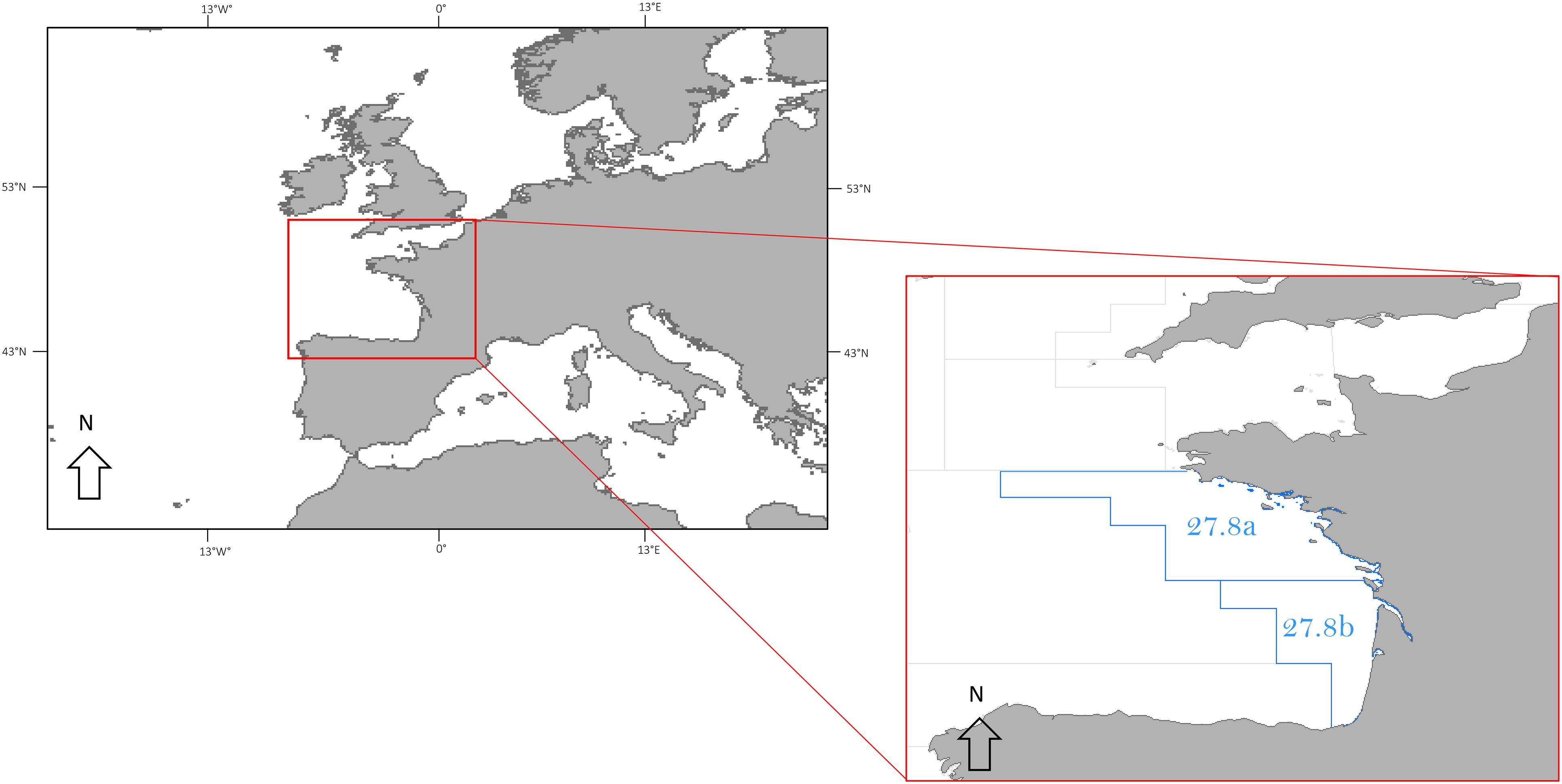
Figure 2. North-East Atlantic Ocean including study area (ICES subareas 27.8.a and 27.8.b) in blue boxes. ICES, International Council for the Exploration of the Sea.
The analyses, detailed in the following sections and represented in Figure 3, involved four main steps:
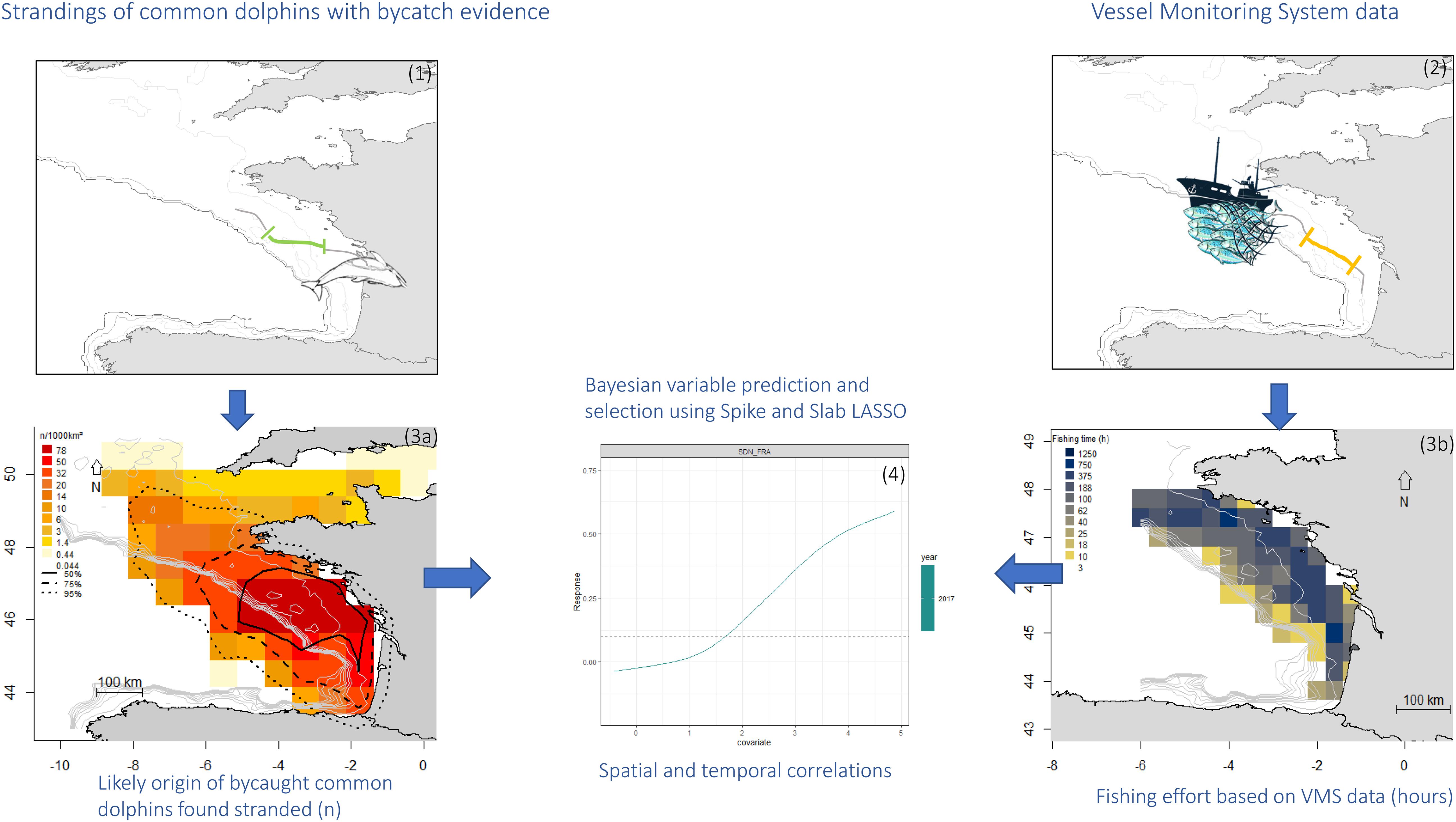
Figure 3. Schematic representation of methodology used. UME, unusual mortality event; VMS, Vessel Monitoring System. (1) Reverse trajectory of stranded dolphins; (2) Inferred trajectory of fishing vessel; (3a) Origin of bycaught dolphins found stranded during a UME (n); (3b) Fishing effort at the time of UME (hours); (4) Bayesian variable prediction and selection using spike-and-slab LASSO | Spatial and temporal correlations.
(1) Predicting the reverse trajectories of stranded common dolphin carcasses with bycatch evidence to estimate the mortality area of each animal;
(2) Inferring the trajectories of fishing vessels longer than 12 m from VMS data and estimating fishing effort;
(3) Aggregating the dolphin bycatch areas during an UME (Figure 3a) and the total fishing effort (Figure 3b) on a regular grid spanning the Bay of Biscay;
(4) Fitting Spatial Generalized Additive Models within a Bayesian framework to explore the spatial and temporal co-occurrence of fishing effort and the origins of stranded bycaught dolphins.
All analyses were performed in the R software environment, version 4.0 (Ihaka and Gentleman, 1996; R Core Team, 2020); bathymetric maps were plotted with the R library marmap (Pante and Simon-Bouhet, 2013).
Estimating Mortality Areas From Strandings
Data on marine mammal strandings in France are collected by the French Stranding Network (Réseau National Echouages), coordinated by Observatoire Pelagis (CNRS/La Rochelle University), as mandated by the French Ministry in charge of the Environment. More than 400 trained volunteers collect information on stranded animals along the entire French coast following a standardized protocol (Van Canneyt et al., 2015).3 The details of a stranding can be used to infer where the carcass originated by calculating its reverse drift trajectory from the location where it stranded.
The common dolphin carcasses retained for analyses included only fresh or slightly decomposed individuals with evidence of bycatch and/or which stranded during a UME (Peltier et al., 2020). Evidence of bycatch includes: net marks; good nutritional condition; evidence of recent feeding; jaw and rostrum fractures; froth in the airways; edematous lungs; and amputations of the dorsal fin, pectoral fins or tail fluke (see details in Kuiken, 1994; Bernaldo de Quirós et al., 2018). A combination of several of the above criteria and the lack of evidence for any other cause of death indicate bycatch to be the cause of death. All diagnoses are validated by Observatoire Pelagis based on data collected, examination reports and detailed photographs.
The reverse drift trajectories of stranded common dolphins with bycatch evidence were calculated using the drift prediction model MOTHY (Modele Oceanique de Transport d’HYdrocarbures), initially developed by Météo-France to predict the drift of oil spills and later adapted to solid object drift prediction (Daniel et al., 2002). MOTHY predicts the drift of a floating object under the influence of tides and winds, based on a global meteorological model validated by observations.
The drift duration of carcasses was inferred from the decomposition status and visual criteria describing body decomposition (Peltier et al., 2012). Animals categorized as “fresh” were estimated to be <5 days post-mortem and animals classified as “slightly decomposed” to be 5–15 days post-mortem. One location was retained for each day within the time window corresponding to the decomposition code of each individual, and locations were weighted in order to obtain a total weight of 1 animal per drift. Locations of carcass drifts were summed in each cell of a 0.4° × 0.4° grid covering the Bay of Biscay. Locations of fresh and slightly decomposed animals were summed separately: carcasses found stranded at the same time but in different decomposition states (in other words with different drift durations) would have died on different dates and potentially in different areas.
Fishing Effort Data
European fishing vessels longer than 12 m have been required under EU regulation to be equipped with VMS transmitters since 2010. Data from vessels in French waters are collected and archived by Ifremer’s Fisheries Information System (Système d’Informations Halieutiques, SIH),4 managed by the Directorate of Marine Fisheries and Aquaculture (Direction des Pêches Maritimes et de l’Aquaculture, DPMA). The VMS data recorded includes the date, time and position of the fishing vessels at an hourly resolution. Ifremer analyzes these locations to compute fishing effort, mostly from vessel speed: vessels are considered to be actively fishing if their mean traveling speed is less than 4.5 knots, and in transit otherwise.
Fishing effort is provided at a daily resolution in a 0.05° × 0.05° grid, and anonymized information related to fishing vessels is given (flag, size category, harbor, and gear classification). Only trawls, nets and seines were considered, because dredges, longlines and pots are not believed to generate small cetacean bycatch in the Bay of Biscay. Combinations of nine different gears and nine different flags were tested (Table 1).
Available VMS data of non-French fisheries operating in French waters (ICES subareas 27.8.a and 27.8.b) could not be linked to the actual gear used during fishing operations, only to the gear identified in the initial description of the EU fishing fleet register. For the French fleet only, VMS data are complemented by declarative landing statistics (logbooks and sales provided by the Ministry in charge of Fisheries) and Ifremer survey data in order to provide fishing effort data related to the species and quantity of fish landed. Note that fishing effort (in hours) in a dedicated cell is equally allocated to every fish species caught in that cell, irrespective of the caught quantity.
Several hundreds of gear/species associations can be recorded within a UME and they cannot all be tested. As a first filter, only caught species constituting more than 10% of fishing effort in at least 50% of events recorded within a year were retained. In the end, 22–37 gear/species combinations were tested for spatial correlation with strandings (Table 2). Maps of fishing efforts tested are available online (see Shiny appendix http://pelabox.univ-lr.fr:3838/pelagis/ShinyApp_v2/). Correlations were tested at the temporal resolution of the different UMEs in ICES subareas 27.8.a and 27.8.b (Table 3).
Aggregation of Data on a Common Grid Covering the Bay of Biscay
A “block averaging” method was used in order to spatially smooth the raw sums computed as above (Petitgas et al., 2014; Peltier et al., 2020). This method averages the data by block over the 0.4° × 0.4° grid, spanning 43°N–47°N and 1°W–4°W. The value in the first block (block 0, origin = x0) is the sum of the weighted locations within the block. The point origin (x0) from block 0, in the lower left corner, was randomized 100 times. At each randomization k, the grid origin xk varies and the sum of animals that died in each cell is calculated. Each block then has 100 sums associated with it. The mean of all 100 sums was then calculated and assigned to the location at the center of the block. This block-averaged dataset is similar to a kernel interpolation (Petitgas et al., 2014) and was used to smooth the response variable to mimimize the potential effects of outliers at the boundary of the study area. This procedure also produced spatial correlation in the smoothed data, which was considered in downstream analyses (see section “Co-occurrence Analysis”). Fishing effort data, initially on a 0.05° × 0.05° grid, were upscaled to the same 0.4° × 0.4° grid as the dolphin bycatch data.
Co-occurrence Analysis
Spatial Generalized Additive Models (sGAMs) were used to explore the spatial overlap between fishing effort and bycatch locations estimated from strandings. Each year was considered independently, but could include several UMEs (combinations of UME dates and decomposition statuses of dolphins) (Table 4). For each event, a grid of dolphin bycatch locations at sea was built and analyzed with corresponding fishing effort datasets on the same grid over the same dates. Each cell in the grid thus constituted an individual datapoint for the correlation analyses.
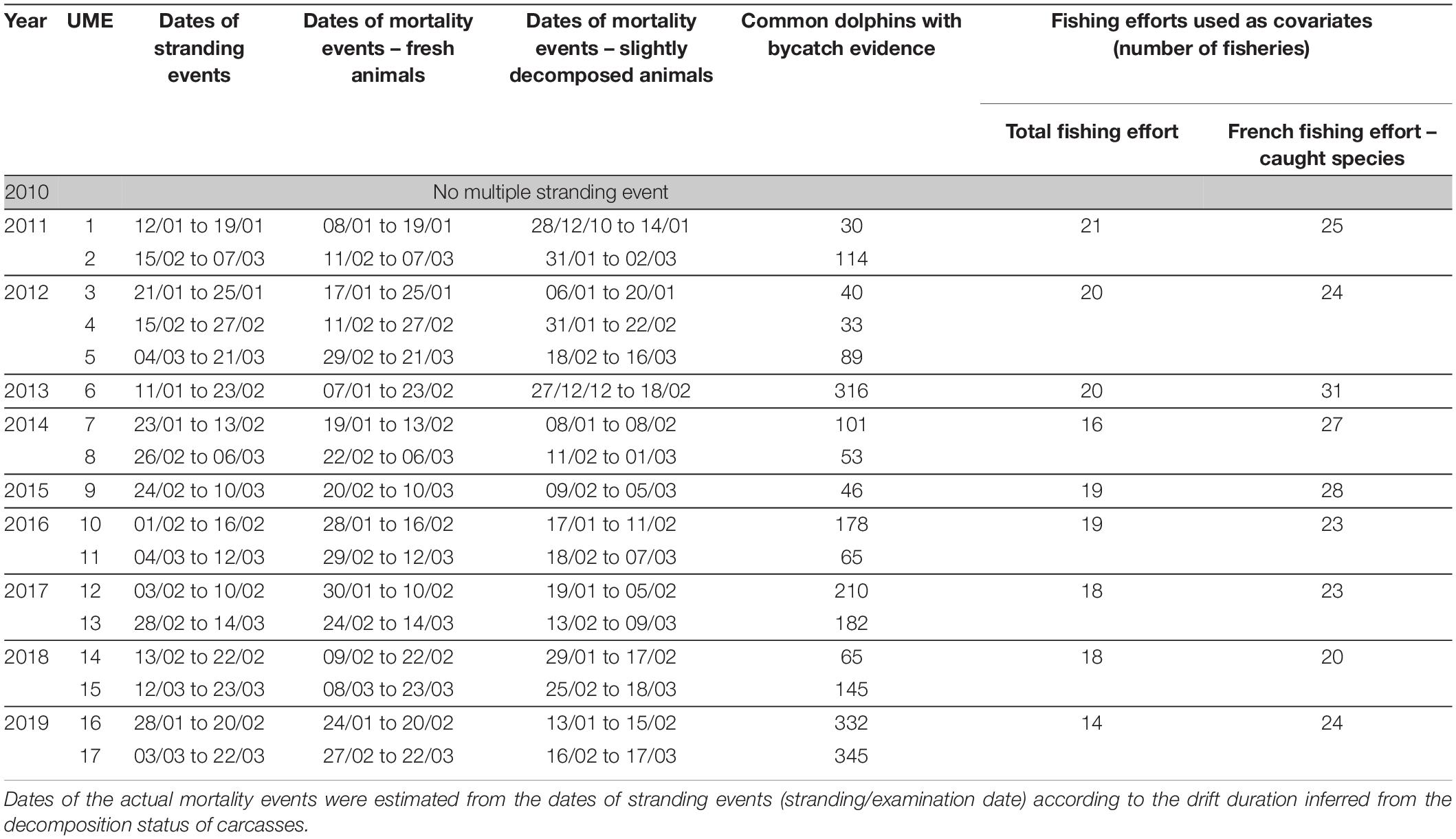
Table 4. Details of unusual mortality events (UMEs) used to identify correlations with fishing effort.
The response variable was the density of bycaught dolphins inferred from strandings, and the explanatory covariate was fishing effort in hours. All variables were log (1 + x) transformed before analysis, and a Gaussian likelihood was assumed for the sGAM. In contrast to the Peltier et al. (2020) study, which focused on a single event in 2017 and 10 fisheries, we investigated nine years and also included information on commercial species targeted by fisheries. This increased the number of covariates to consider. Consequently, we used a Bayesian framework with penalized regression and performed automatic variable selection fitted with spike-and-slab priors (O’Hara and Sillanpää, 2009) to assess associations between multiple fisheries and dolphin bycatch. The variable selection and model choice with a spike-and-slab prior structure enables the selection or deselection of single coefficients or blocks of coefficients (Scheipl, 2011). These features are key, since a large number of covariates can be included in the model, and non-linear relationships between fishing effort and dolphin mortality are allowed and estimated from data.
These two requirements, namely (i) the need to allow for non-linear relationships and (ii) the ability to select the most important covariates among a large number of covariates, motivated the use of Bayesian variable selection, model choice and regularized estimation with spike-and-slab priors in an additive mixed model framework (Scheipl, 2011). Importantly, within the framework of regularized regression, covariate selection is achieved in a single model run (Authier et al., 2017). The expression ‘spike-and-slab’ refers to a mixture prior distribution for model coefficients. This prior is made up of a diffuse and vague distribution (the slab) and a degenerate distribution at 0 (the spike). The spike pulls coefficients for which there is no information in the data on their effects to 0, thereby achieving variable selection. The slab allows important coefficients to escape this pull towards 0 and to be accurately estimated. Spike-and-slab regression requires fitting only one model to achieve model selection compared with alternative procedures based on information criteria. The interested reader is referred to O’Hara and Sillanpää (2009) for an overview of Bayesian model selection methods, and to Scheipl (2011) for all details on GAMs with spike-and-slab priors. Finally, an important feature of the dolphin bycatch data to be accounted for is spatial autocorrelation. SpikeSlabGAM allows for the inclusion of spatially correlated residuals with a Gaussian Markov Random Field (GMRF) model whereby the neighboring structure intrinsic to our grid data is taken into account.
For sGAM modeling, we used the spikeSlabGAM package (Scheipl, 2011). By default, SpikeSlabGAM uses cubic B-splines with 2nd order difference penalties to model non-linear relationships. Data analyses were carried out on a per year basis: for each dataset, 4 chains were run for 5,000 iterations, discarding the first 1,000 as burn-in. Thinning was set to 4 (that is, one iteration kept out of 4) yielding a final sample of 1,000 values from the posterior for further inference. All sGAMs included a GRMF term to account for spatial autocorrelation. Upon convergence of all parameters in each model, results were then visualized using the built-in plotting capabilities of SpikeSlabGAM to visually assess the sign of the (potentially non-linear) relationship between dolphin bycatch and fishing effort. For statistical reasons, the low fishing effort of some European fleets in winter prevented the testing of the co-occurrence of their fishing effort with the origin of bycaught dolphins. For brevity, estimated relationships were presented only for gears that positively correlated with mortality areas in at least two years between 2016 and 2019.
Results
Strandings
Common dolphin strandings varied greatly over the study period (Figure 4). The average over the entire study period (1990–2019) was 340 ± SD 256 stranded individuals per year, while the average between 2010 and 2019 was 542 ± SD 303, and 860 ± SD 206 between 2016 and 2019. The last four years in the study period had the highest numbers of strandings.
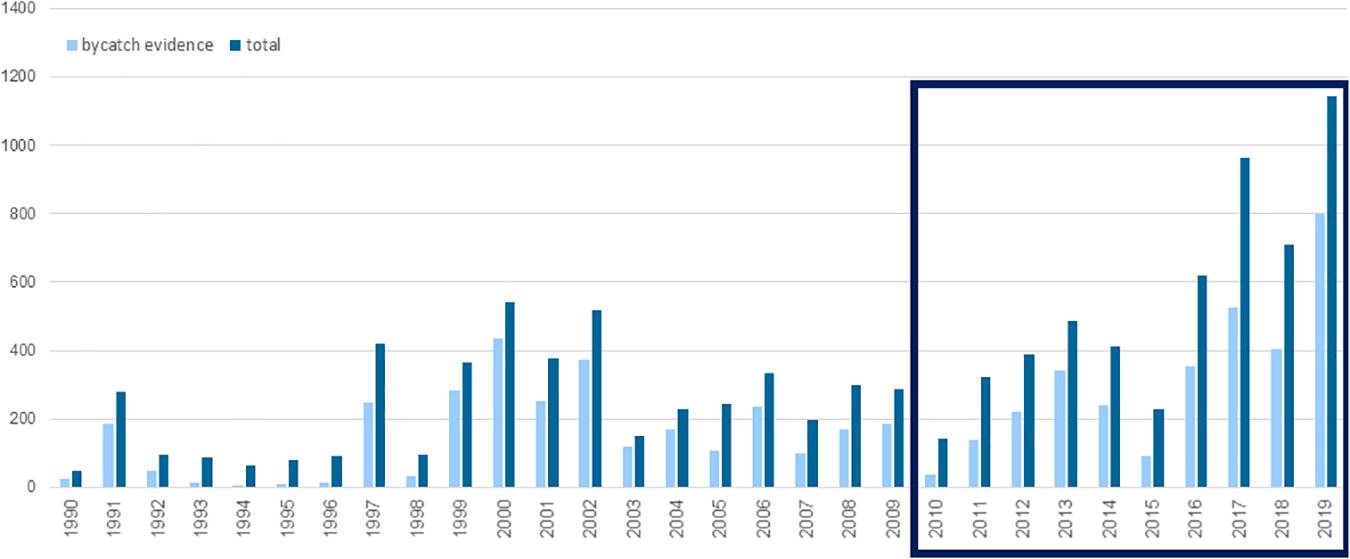
Figure 4. Long term time series of common dolphin strandings along the French Atlantic coast, from 1990 to 2009. Dark blue bars represent all common dolphin strandings, light blue bars represent examined common dolphin strandings (fresh or slightly decomposed) with bycatch evidence. The dark blue box incorporates the years included in the study to identify positive correlations between mortality areas and fishing effort.
Numbers of fresh and slightly decomposed carcasses with evidence of bycatch followed a pattern similar to total stranding numbers. The average number of strandings with bycatch evidence was estimated at 205 ± SD 177 common dolphins per year for the entire study period (1990–2019), while the average in the last four years increased to 520 ± SD 172.
Since 2011, 17 common dolphin UMEs were recorded along the French Atlantic coast, all related to bycatch (Table 4). The magnitude of these events, both in duration and in number of individuals varied greatly. No multiple stranding events were recorded in 2010, but one to three events were observed along the French Atlantic coast each year starting in 2011, with an average of 138 ± SD 104 common dolphins showing evidence of bycatch per event.
The proportion of common dolphins with bycatch evidence recorded during a UME ranged from 49 to 92% of the total bycaught dolphins found stranded within a year.
Likely Origin of Stranded Common Dolphins
At least 75% of stranded common dolphins with bycatch evidence originated from the continental shelf of the Bay of Biscay. Some came from the Western Channel, but to a lesser extent (Figure 5). In 2011, 2012, and 2013, more than half of common dolphin carcasses originated from the southern Bay of Biscay. Between 2014 and 2016, the origins of bycaught dolphins were homogeneously distributed between the Spanish border and southern Brittany. During the last three years of the study period, the highest densities of dolphin mortality locations (>40 individuals/1,000 km2) were inferred between 46°N and 47.5°N.
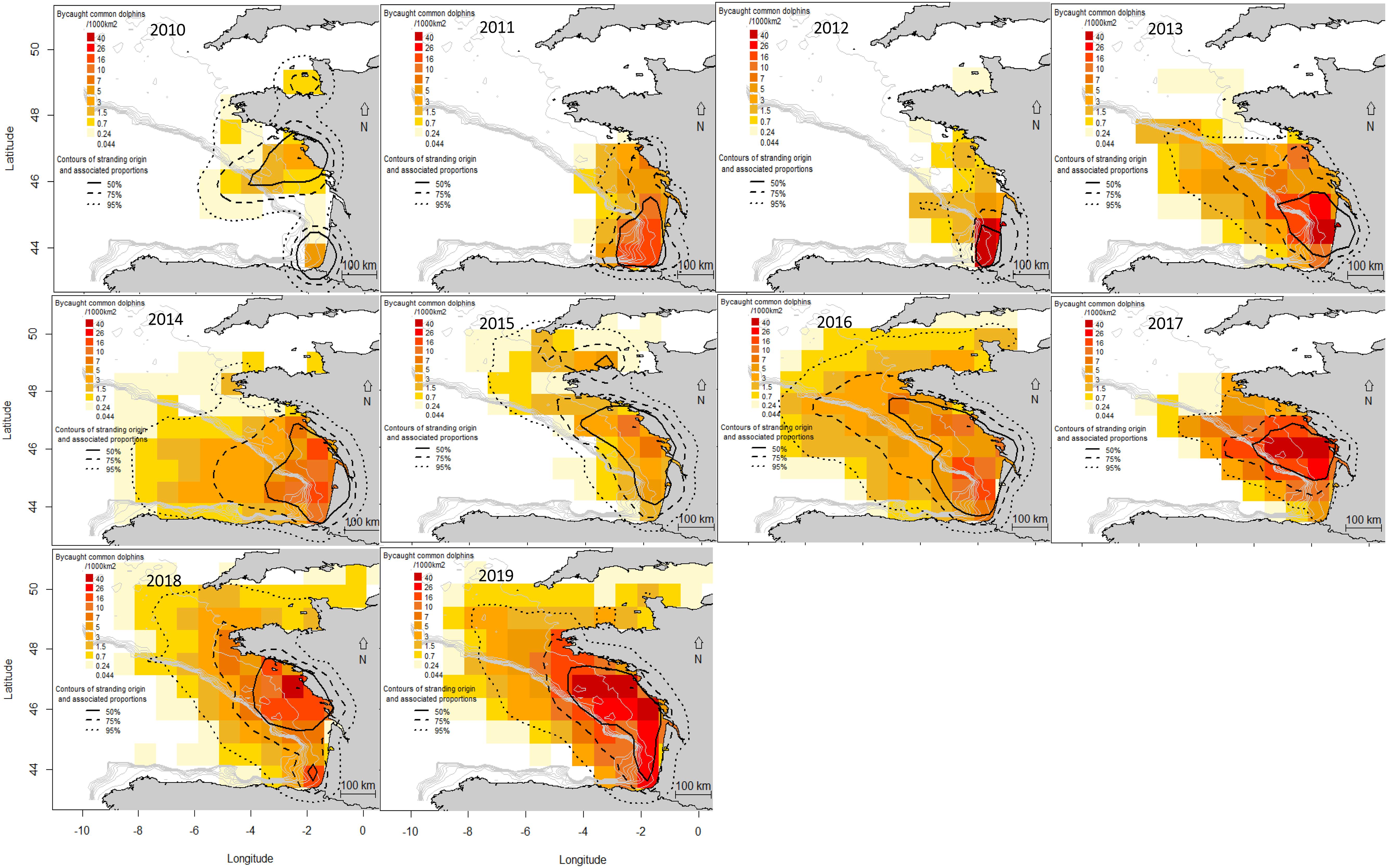
Figure 5. Origin of stranded common dolphins with bycatch evidence. Densities are presented in dead dolphins/1,000 km2. The areas defined by solid lines included 50% of stranded dolphins, dashed lines included 75% of stranded dolphins and dotted lines 95% of stranded dolphins.
Co-occurrence of Dolphin Mortality Areas and Fishing Effort
During UMEs, French trammel netters (GTR) were positively correlated with dolphin mortality areas in eight of the nine years tested (Table 5 and Figure 6). French gillnetters (GNS) and Spanish bottom trawlers (OTB) were positively correlated with mortality areas in six years. French pair midwater trawlers (PTM), Spanish gillnetters (GNS), and Danish seiners (SDN) co-occurred with common dolphin bycatch events in three to four of the years, mostly in the years with the highest bycatch numbers (between 2016 and 2019). Six other fishing gears correlated positively with mortality areas in only one or two years after 2010, and among them.
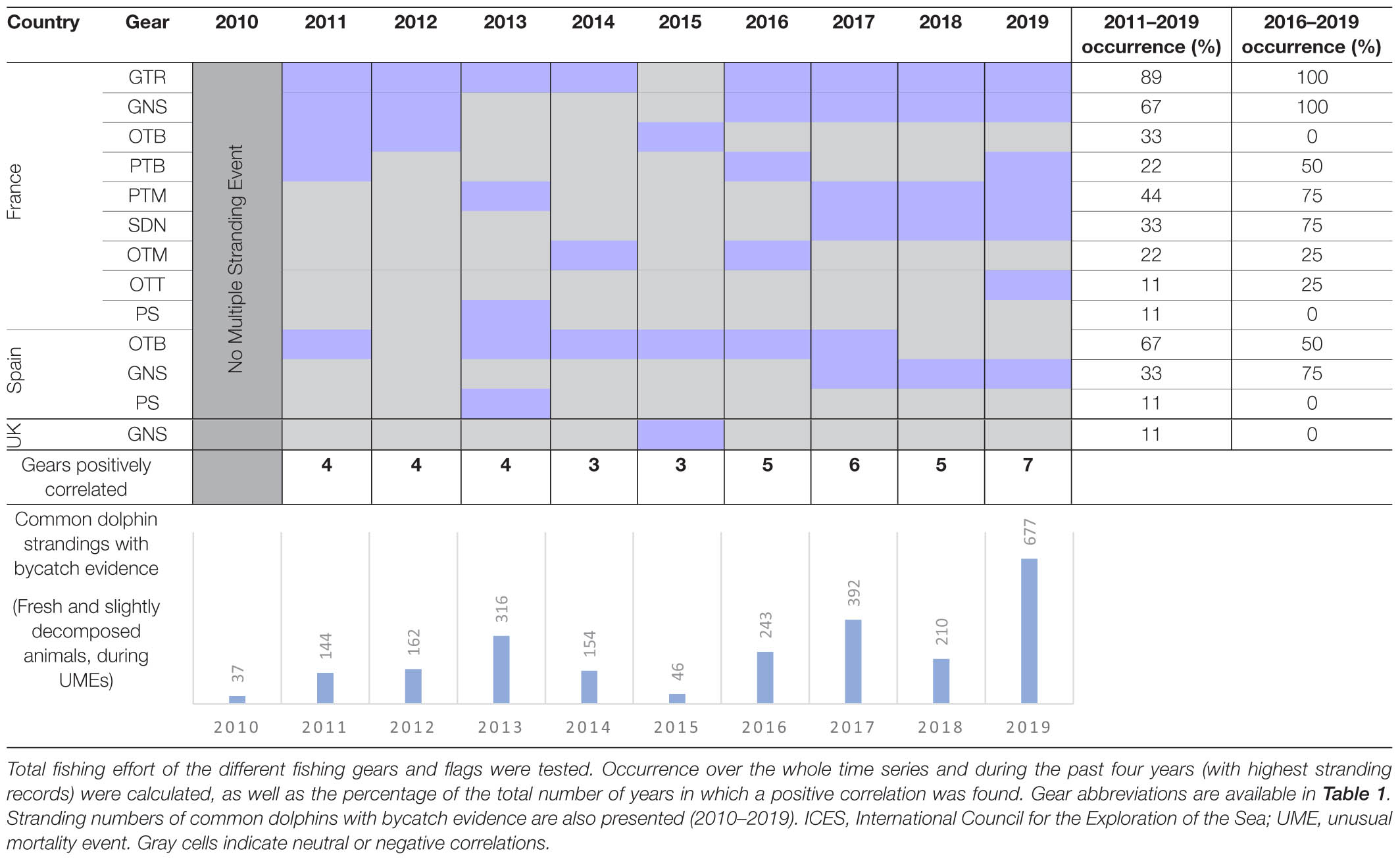
Table 5. Time series of positive correlations (in blue) between fishing effort and origin of bycaught common dolphins in ICES subareas 27.8.a and 27.8.b (2010–2019).
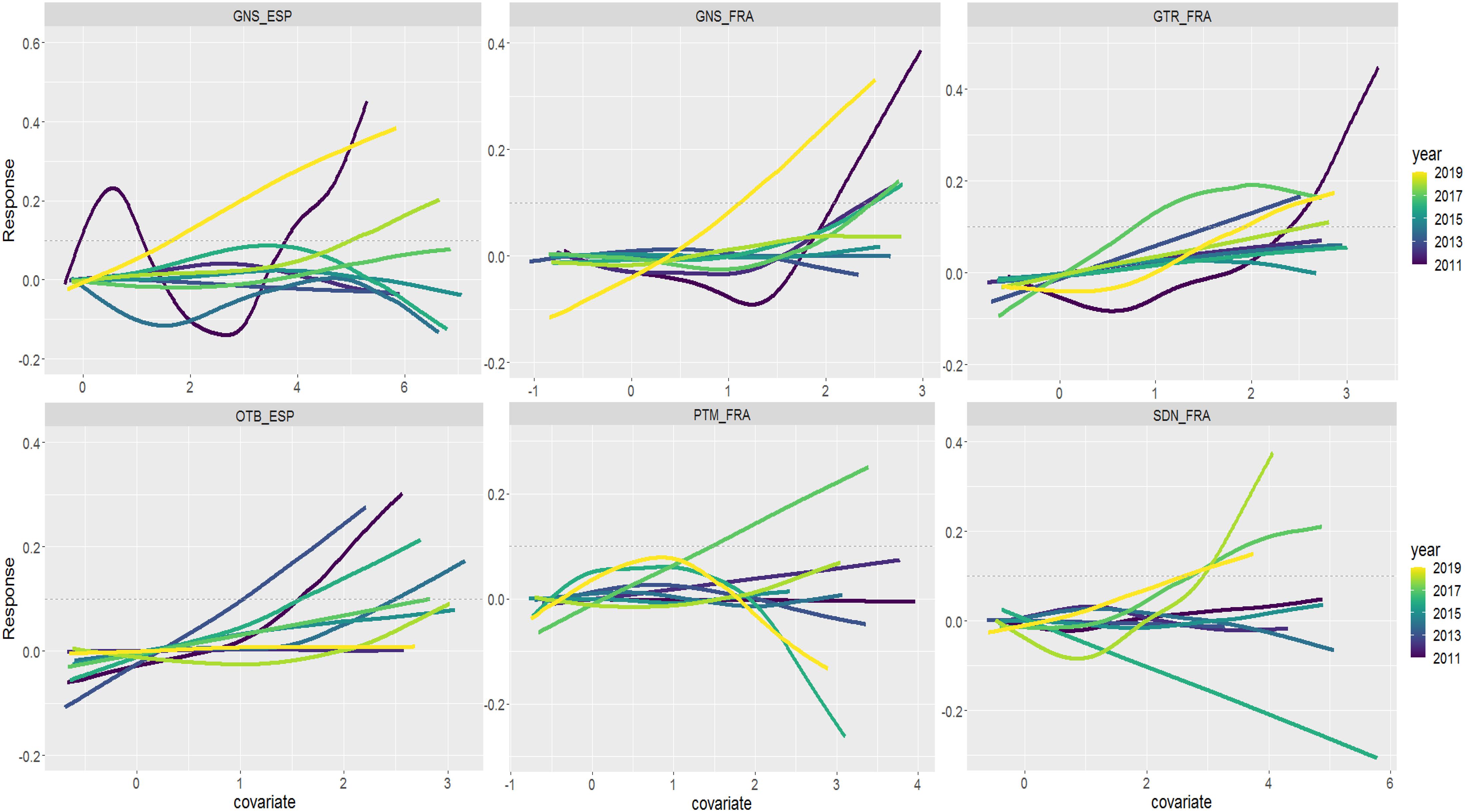
Figure 6. Functional relationships between the origin of bycaught common dolphins and fishing effort in ICES subareas 27.8.a and 27.8.b for Spanish gillnetters (GNS_ESP), French trammel netters (GTR_FRA), French gillnetters (GNS_FRA), Spanish bottom trawlers (OTB_ESP), French midwater pair trawlers (PTM_FRA), French Danish seiners (SDN_FRA). Note that only fisheries which correlated positively at least twice since 2016 are presented. ICES - International Council for the Exploration of the Sea.
For the French fleets, fishing efforts of gillnetters catching hake (Merluccius merluccius) were positively correlated with mortality areas every year except 2014, and the efforts of midwater pair trawlers targeting sea bass (Dicentrarchus labrax) were positively correlated in six of the nine years tested (Table 6 and Figure 7). The correlations were positive in all of the last four years which had the highest levels of bycaught dolphin strandings (2016–2019). Trammel netters catching anglerfish (Lophius spp.) were positively correlated in six of the nine years too, including 2016–2018. Midwater pair trawlers were positively correlated when catching mackerel (Scomber scombrus) in four of the tested years, and in three years (including 2017 and 2018) when catching hake. Positive correlations were detected in bottom pair trawlers catching hake in three of the years, only after 2016. Danish seiners catching various species [sea bass, cuttlefish (Sepia officinalis), mackerel and whiting (Merlangius merlangus)] only correlated positively in two of the years. Nevertheless, this fishing gear appeared correlated only in recent years, mostly when catching whiting (2017 and 2018). Midwater otter trawlers, twin otter trawlers and otter bottom trawlers—all targeting various species, as well as purse seiners catching pilchards (Sardina pilchardus) and trammel netters catching sea bass and sole (Solea solea) were all positively correlated with mortality areas only once in the time series.
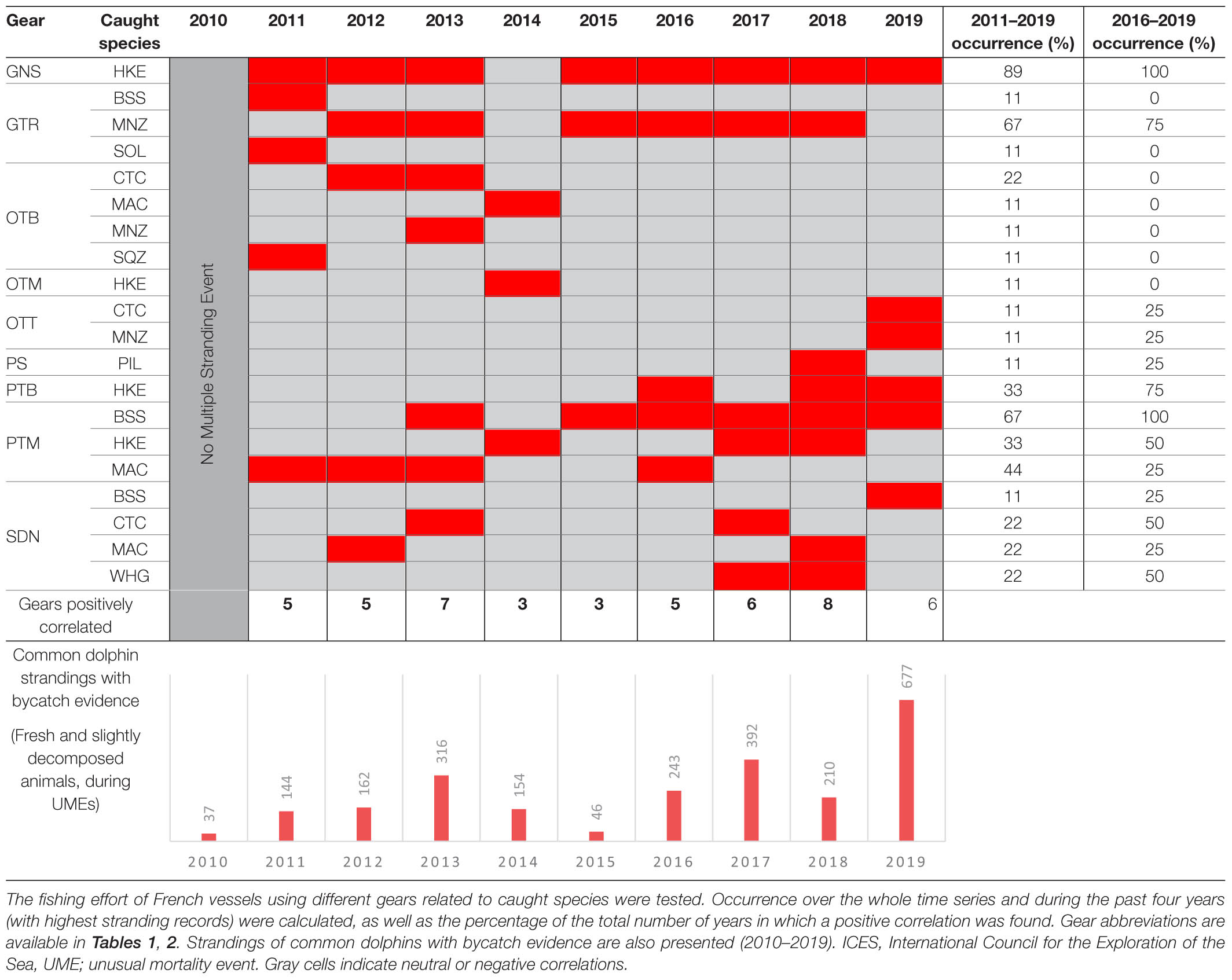
Table 6. Time series of positive correlations (in red) between fishing effort and origin of bycaught common dolphins in ICES subareas 27.8.a and 27.8.b (2010–2019).
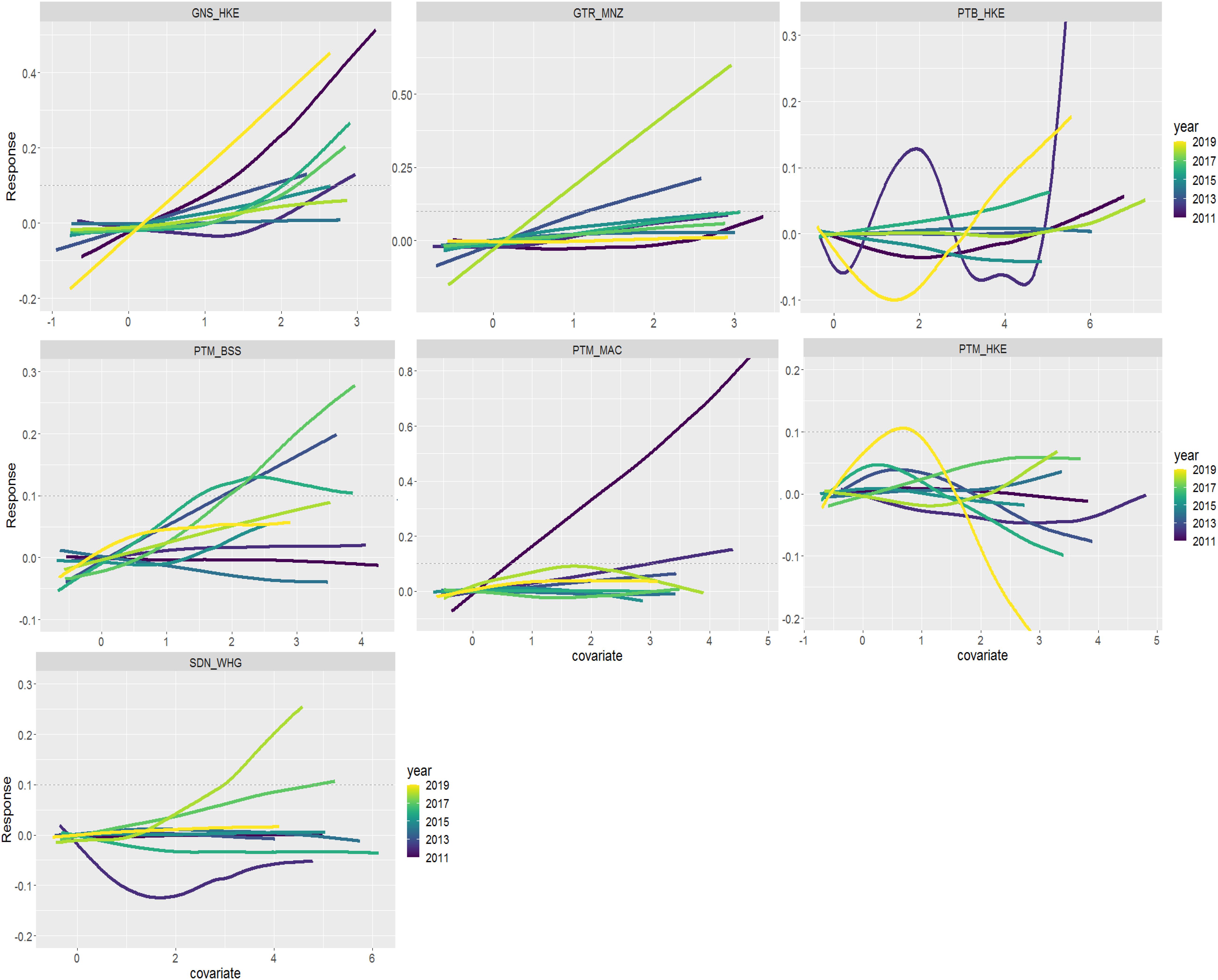
Figure 7. Functional relationships between the origin of bycaught common dolphins and fishing effort in ICES subareas 27.8.a and 27.8.b for French fleets according to caught species: gillnetters catching hake (GNS_HKE), trammel netters catching anglerfish (GTR_MNZ), bottom pair trawlers catching hake (PTB_HKE), midwater pair trawlers catching sea bass (PTM_BSS), midwater pair trawlers catching mackerel (PTM_MAC), Danish seiners catching whiting (SDN_WHG). ICES, International Council for the Exploration of the Sea.
Hake constituted the most recurrent target species in fishing efforts positively correlated with mortality areas, being targeted by four different fishing gears. Sea bass and mackerel were also regularly targeted in positively correlated fishing efforts.
The year 2014 was unusual in that the fishing efforts of two fisheries—bottom otter trawlers catching mackerel and midwater otter trawlers catching hake—correlated positively with dolphin mortality areas, but these two fisheries were never identified in other years.
Discussion
General
The recent increase in common dolphin strandings along the French Atlantic coast occurred mostly in ICES subareas 27.8.a and 27.8.b. The use of reverse drift modeling to infer the likely at-sea origins of stranded dolphins highlighted the continental shelf of the Bay of Biscay as a mortality hotspot, in particular the area between latitudes 46°N and 47.5°N in recent years. The expansion of bycaught common dolphin mortality areas from the southern into the northern Bay of Biscay and the sharp increase in stranding numbers happened simultaneously after 2016. The boundaries of the likely mortality areas must be carefully interpreted as the grid used is rather coarse (0.4° × 0.4°). The West-East extension, mostly in the oceanic area (beyond the continental slope) can be attributed to reverse drift modeling and methodological uncertainties such as the absence of current modeling in coastal areas, time-of-death estimates, or the grid resolution.
Unusual mortality event detection is based on the analysis of cetacean carcasses following a standardized protocol. The decomposition state of carcasses is a major factor in diagnosing bycatch (Peltier et al., 2020). Net marks can easily be missed on decomposed carcasses, as the epidermis may be damaged or missing, and edematous lungs can be indistinguishable due to decomposition processes. The proportion of carcasses that are fresh or slightly decomposed is directly related to the distance to shore and drift conditions at the time of death (Bibby and Lloyd, 1977; Hlady and Burger, 1993; Peltier et al., 2013). Because of seasonal changes in fishing practices and dolphin distribution, the fisheries involved could differ between spring or summer bycatch events.
Estimates of fishing effort were derived from locations recorded by VMS transmitters on larger vessels. Fishing effort must be carefully interpreted because VMS transmitters have been mandatory only on vessels >12 m long since 2010 (Commission Regulation (EC), 2009). In 2018, 73% of the French fleet operating from Atlantic harbors was constituted of vessels <12 m long; 1,090 smaller fishing vessels were registered in the community fishing fleet register (IFREMER, 2019). Smaller vessels andsmall scale or artisanal fisheries are still largely overlooked, despite their potential threat to cetacean populations having been demonstrated (Zappes et al., 2013; Cruz et al., 2018).
The calculation based on vessel speed is applied to all gears, both towed and static. The assumption that vessels under 4.5 knots are actively fishing is mostly relevant for towed gears, as trawl, seine or dredge operations require slow speeds. Nevertheless, false-positive results, i.e., vessels traveling at low speed but not engaged in fishing, can be generated using this vessel speed filter. However, false-positive results probably represent a low fraction of estimated fishing time (Bertrand et al., 2008; Gerritsen and Lordan, 2011). Applying this methodology to static gears probably produces fishing effort data that are more difficult to interpret. The low speed of vessels operating static gear can be detected when the gears are set or hauled. Still, the use of VMS data to assess fishing effort is relevant to highlight changes within years, as long as fishing efforts are not directly compared between gears.
The long-term analysis highlighted seven different fisheries whose fishing efforts positively correlated with dolphin mortality areas in at least two years between 2016 and 2019, the period with the highest numbers of strandings recorded since the establishment of the French Stranding Network in the 1980s.
For the French fleet, correlations within the two fishing effort datasets were consistent overall (total effort per gear and fishing effort per landed species and gear). Nevertheless, positive correlations of fishing efforts from these two datasets with dolphin mortality areas did not necessarily occur simultaneously (Figure 8).
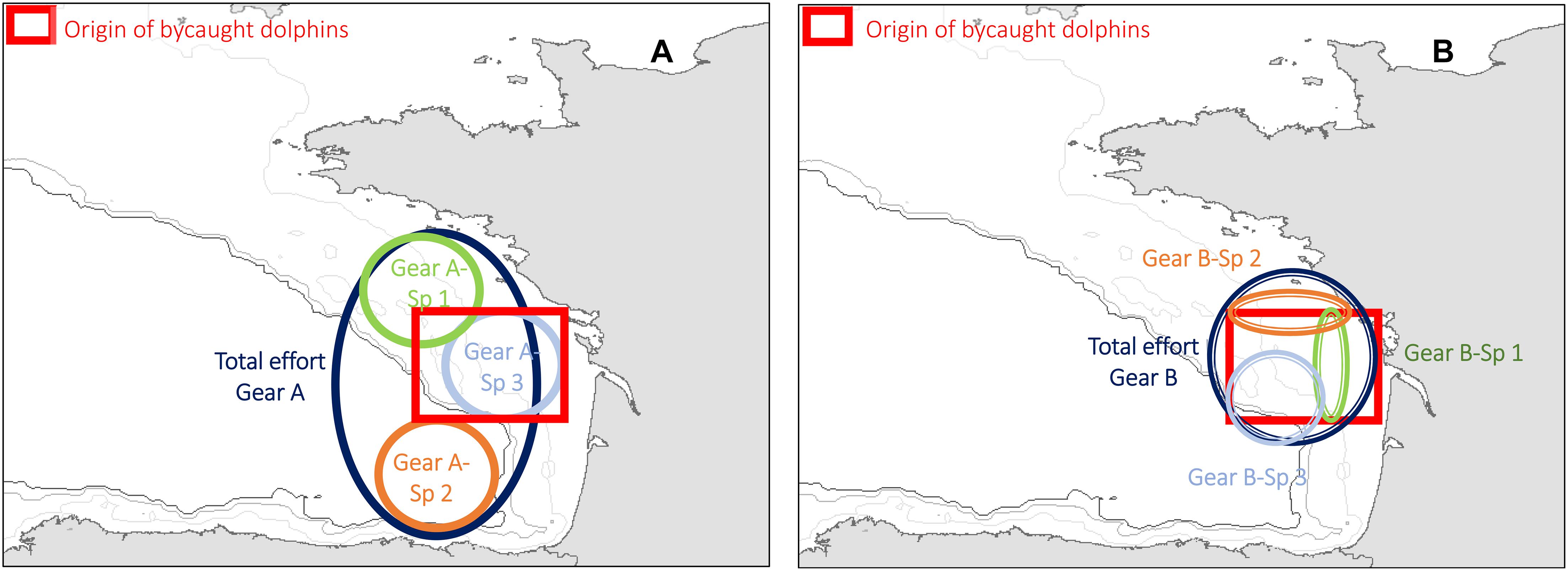
Figure 8. Theoretical co-occurrence of the origin of stranded dolphins and fishing effort in two distinct scenarios. The red box represents the origin of stranded bycaught dolphins. In panel (A), the total effort of gear A is presented and only the effort dedicated to catching species 3 correlates with the origin of the strandings. In panel (B), the origin of the strandings is positively correlated with the total fishing effort including all three species; individually considered, fishing effort for each of the different species is not correlated.
The joint analysis of VMS data and the origins of stranded bycaught common dolphins in the Bay of Biscay provide relevant and realistic information with regards to fisheries potentially responsible for common dolphin bycatch. Nevertheless, co-occurrence does not imply causality, merely that both phenomena occurred at the same place at the same time. In fact, positive correlations can be identified for fisheries that cannot generate dolphin bycatch (e.g., longlines, traps, pods, etc.) but shared common fishing grounds with the fisheries responsible. Moreover, the degree of correlation does not indicate the intensity of the interaction, as bycatch events can be intense and limited in space and time.
Fisheries of the Bay of Biscay
The Bay of Biscay is an important area for the fishing industry, fishing effort is intense in this region (Kroodsma et al., 2018). The fisheries operating in ICES subareas 27.8.a and 27.8.b are highly diverse in terms of their flags, gears used, and species targeted (SIH—Système d’informations halieutiques, http://sih.ifremer.fr/). Around 2,000 fishing vessels were active in this area in the year 2018 (Demanèche et al., 2019). The breakdown by flag was as follows: 1,486 French vessels, including 1,072 vessels <12 m; 300 Spanish vessels (average size of 25 m); 22 Irish vessels (average size of 33 m); 18 British vessels (average size of 37 m); 12 Belgian vessels (average size of 37 m); 5 German vessels (average size of 41 m); 3 Dutch vessels (average size of 113 m) and one Danish trawler (size of 70 m). Because of the great diversity of vessels operating in the Bay of Biscay, only fisheries positively correlated with likely common dolphin bycatch areas will be described.
Most of the French vessels deployed nets (39%; gillnets and trammel nets). Only 17% of them were equipped with VMS transmitters (Demanèche et al., 2019). The maximum activity was recorded in spring and summer. The number of netters in the Bay of Biscay decreased over the study period, but “fishing effort” (or “indicator of set and haul time”) remained quite stable for vessels >12 m after 2010 (Supplementary Figure 1). The decrease in netters was mostly due to the reduction of smaller vessels, whereas the number of larger vessels above 15 m was stable or even increased (>24 m). Fishing activity of smaller vessels (<12 m) remained mostly coastal, within the 12 NM limit. The main species landed by smaller netters in winter were sole, pollock and sea bass, whereas hake, sole and anglerfish were mostly landed by larger netters, Hake landings doubled between 2013 and 2018 for netters of all size categories (Demanèche et al., 2019; Supplementary Figure 2). Bottom trawlers (single and paired) constituted 30% of the vessels operating in the Bay of Biscay in winter, and 57% of them were equipped with VMS transmitters. The main species landed by bottom trawlers were anglerfish and hake. Bottom pair trawlers targeted mostly hake, and landings remained stable after 2010 (Supplementary Figure 2). Midwater pair trawlers represented 5% of fishing vessels in ICES subareas 27.8.a and 27.8.b in 2018; 84% of which were above 12 m. Catches of sea bass by midwater pair trawlers decreased greatly after the 2010 winter, whereas hake landings increased between 2014 and 2017, and decreased in 2018 and 2019. Fishing effort associated with hake catches occurred mostly in winter along the 100 m isobath, south of 46°N in 2016 and north of 45.5°N after 2017 (see Shiny appendix http://pelabox.univ-lr.fr:3838/pelagis/ShinyApp_v2/). Similar patterns were highlighted for sea bass catches. French Danish seiners, operating in the Bay of Biscay since 2009, constituted a small fleet (<1% of vessels in ICES subareas 27.8.a and 27.8.b) and were all equipped with VMS transmitters. They fish both demersal and pelagic species, mostly whiting, mackerel and sea bass. Their main fishing grounds were located between 45°N and 48°N, within the 100 m isobath. Depending on the vessel and target species, the vertical opening of seines can reach several meters while hauling. Although irregular, fishing effort of Danish seiners have been increasing, mostly in 2018 and 2019.
The Spanish fleet operated all year in the study area, with the highest fishing effort recorded between April and November. Almost half of the Spanish vessels operated purse seines targeting anchovies in spring (ICES, 2018). The other half of the fleet included 28% longliners, 21% gillnetters, and 9% bottom trawlers, both pair and single. The trawl fleet operated across the whole Bay of Biscay (see Shiny appendix http://pelabox.univ-lr.fr:3838/pelagis/ShinyApp_v2/), but total fishing effort in winter decreased slightly after 2010 (Appendix 1). The main species landed by Spanish trawlers are hake, anglerfish and megrim (Argyrosomus regius) (ICES, 2019). Winter fishing effort of Spanish gillnetters was relatively stable between 2010 and 2019. The main target species of Spanish vessels using static gear was hake (ICES, 2019).
The fishing effort of British vessels was low but constant throughout the study period, and quite stable after 2010. Only 5 vessels were registered as gillnetters (Demanèche et al., 2019) and generally operated over the whole Bay of Biscay.
Relevance of Identified Fisheries
Fisheries whose fishing efforts correlated positively with dolphin mortality areas were consistent with métiers of concern identified by ICES in subareas 27.8.a and 27.8.b, based on at-sea observations (ICES, 2020c, Table 7). French Danish seiners were the only métier positively correlated with bycatch areas for which no bycatch was recorded by observers between 2016 and 2018. The highest bycatch numbers were observed on trammel netters (GTR) targeting demersal fishes (DEF). Demersal fishes include hake, sea bass, whiting and anglerfish, all of which were positively correlated with bycatch areas. Bottom pair trawlers, targeting a mix of pelagic and demersal species, included a variety of gears and flags (Spanish bottom pair and otter trawlers, and French bottom pair trawlers). Common dolphin bycatch has been documented in bottom pair trawl fisheries targeting hake in North-Western Spain (Fernández-Contreras et al., 2010), which is consistent with the above correlation findings. The fishing efforts of vessels using midwater pair trawls and gillnets to target demersal fish (Table 7) also correlated positively with the mortality areas of bycaught dolphins. Interactions between midwater pair trawls and common dolphins in the Bay of Biscay were documented 20 years ago (Morizur et al., 1999; Northridge et al., 2006): various EU funded projects, including PETRACET (Pelagic TRAwl and CETaceans) and NECESSITY, revealed that in the early 2000s most bycatch of common dolphins in the Bay of Biscay and the Celtic Sea occurred in midwater pair trawls targeting sea bass in winter (Northridge et al., 2006). High levels of common dolphin bycatch were reported in the early 1990s on pair trawling fisheries targeting hake (Murphy et al., 2013; ASCOBANS, 2015).

Table 7. Summary of the bycatch rate and mortality of common dolphins for métiers of concern from at-sea monitoring (ICES subareas 27.8.a and 27.8.b, data pooled 2016–2018), raised using the annual mean of available fishing effort from the Regional DataBase (RDB, i.e., data collected in the context of the Data Collection Framework; in ICES, 2020b).
Midwater pair trawlers targeting large pelagic fish, mostly tuna, operate in the oceanic waters of the Bay of Biscay during summer (ICES, 2020b). Distance from the coast as well as drift conditions in summer make it unlikely that strandings of common dolphins bycaught in tuna fisheries along the French Atlantic coast would be detected (Morizur et al., 1999; Peltier et al., 2013), although high numbers of bycaught common and striped dolphins were recorded in these fisheries in the late 1990s (Rogan and Mackey, 2007), and more recently by at-sea monitoring on midwater pair trawlers targeting albacore (Thunnus alalunga) (ICES, 2020c).
Areas where several predatory fish species were caught - such as sea bass, hake, anglerfish or whiting—correlated positively with common dolphin bycatch areas. Of these predatory species, sea bass, mackerel, hake and whiting have common prey species, including anchovy, sardine, or sprat (Sprattus sprattus) (Quéro and Vayne, 1997; Mahe et al., 2007; Murua, 2010; Spitz et al., 2013). Small pelagic fishes are a large proportion of the common dolphin diet, suggesting a likely ecological and spatial overlap between common dolphins and the correlated catches identified (Pusineri et al., 2007; Meynier et al., 2008; Spitz et al., 2013; Murphy et al., 2019). Schooling behavior in small pelagic fishes can lead to high local densities of various predatory species due to possible mutualism and facilitation processes in aggregation of both prey and predator species (Astarloa et al., 2019).
Management and Conservation Implications
Except for changes in hake landings by various fisheries, no change in either overall fishing effort or general fishing practice (gear or target species) was observed, based on ICES and European Commission required data, that could explain the large increase in stranded common dolphins along the French Atlantic coast after 2016. The increase in bycatch could be the result of changes in fishing practices after 2015 that were not covered by national or EU data requirements. Fishing data required by the EU Data Collection Framework include, among other things: days at sea, fishing days, landed species and weight, and métiers at level 5 of the ICES classification (gear type + target species assemblage, see https://vocab.ices.dk/?ref=1498 for gear description). These data are available at a trimester temporal resolution. Changes in these parameters at large spatial and temporal scales have not been detected in the past 10 years (ICES, 2020b), but small scale changes in fishing practices (height of nets, setting strategies, depth of gear, etc.) could modify interactions with common dolphins. So far, no long-term data have been collected to test these hypotheses. Requirements of robust and relevant at-sea observation data (observer/Remote Electronic Monitoring, REM), supported by a random sampling strategy, are crucial in order to refine studies of the interactions between cetaceans and fishing vessels and therefore to establish effective mitigation strategies (Dolman et al., 2021).
Another possible explanation for the recent increase in bycatch could be a change in dolphin distribution relative to the fishing grounds where fisheries posing the greatest risk of bycatch operate. Driven by ecological factors—such as changes in prey behavior or distribution, or a shift of common dolphins to the coastal waters of the Bay of Biscay - could increase the risk of bycatch. Possible small-scale changes in common dolphin prey distribution could be supported by oceanographic data and fishery surveys in winter.
Conclusion
The fisheries identified to have been actively fishing in the mortality area at the time of bycatch events included three using towed gear (French midwater trawlers, French Danish seiners and Spanish bottom trawlers) and three using static gear (French gillnetters, French trammel netters and Spanish gillnetters). Among the French vessels, seven fisheries occurred simultaneously with common dolphin bycatch at least twice in the years between 2016 and 2019: gillnetters fishing hake, trammel netters fishing anglerfish, bottom pair trawlers fishing hake, midwater pair trawlers fishing sea bass, hake and mackerel, and Danish seiners fishing whiting. Some of these fisheries’ efforts correlated positively with dolphin mortality areas nearly each year since 2010, including French gillnetters (especially those targeting hake), French trammel netters (especially those targeting anglerfish), Spanish bottom trawlers, and French midwater pair trawlers in sea bass fishing areas. The characteristics common to all of these fisheries include high vertical heights (nets) or openings (trawls) and the targeting of predatory fishes in winter.
The diversity of the fisheries this study identified as the potential culprits behind the bycatch events between 2010 and 2019 makes it difficult to suggest specific and adapted mitigation strategies to implement. At-sea observation of fishing vessels, either by on-board observers or Remote Electronic Monitoring (REM), is therefore crucial to further investigate and validate studies related to the bycatch issue and help mitigate the threat of bycatch more effectively and precisely in the future. At this point, it seems that only the closure of certain fishing areas at specific times following different potential scenarios could achieve EU requirements in terms of bycatch reduction (ICES, 2020c).
Data Availability Statement
The data analyzed in this study is subject to the following licenses/restrictions: VMS data used in this article are subject to specific convention with French ministry in charge of agriculture and fisheries. Therefore, these data cannot be freely and fully available online as Supplementary Material. Agregated data are avalaible online (http://pelabox.univ-lr.fr:3838/pelagis/ShinyApp_v2/). Stranding data are freely available online (location, date and species) (http://seamap.env.duke.edu/dataset/1406). For detailed stranding data, please send request to corresponding author or Pelagis. Requests to access these datasets should be directed to cGVsYWdpc0B1bml2LWxyLmZy or HP, aHBlbHRpZXJAdW5pdi1sci5mcg==.
Ethics Statement
Ethical review and approval was not required for the animal study because this work required no particular permit, and so, the authors have adhered to general guidelines for the ethical use of animals in research, the legal requirements in France and respective institutional guidelines.
Author Contributions
HP: perform analyses, conception, and writing of the paper. WD, CD, FD, EM, and OV: coordination of the French stranding network and collect of stranding data. MA: support in analysis, support in paper conception and correction. PD: conception of the drift prediction model. JS, FC, VR: support in manuscript conception and correction. All authors contributed to the article and approved the submitted version.
Conflict of Interest
HP, MA, CD, and FD were employed by company ADERA.
The remaining authors declare that the research was conducted in the absence of any commercial or financial relationships that could be construed as a potential conflict of interest.
Acknowledgments
We would like to thank the Fisheries Information System team from IFREMER (http://sih.ifremer.fr/), especially Emilie Leblond for preparing and providing the data on fishing effort distribution and for her availability and help in managing and analyzing this data set. We also thank the Direction des Pêches Maritimes et de l’Aquaculture for allowing data to be made available by IFREMER. We are grateful to all the members of the French stranding scheme for their continuous effort in collecting data on stranded cetaceans. We thank Auriane Virgili for creating the Shiny appendix, and Bruno Mansoux for uploading it. The Observatoire PELAGIS is funded by the Ministry in charge of the Environment, the French Office for Biodiversity (Office Français pour la Biodiversité—AFB) and the Communauté d’Agglomération de la Ville de La Rochelle.
Supplementary Material
The Supplementary Material for this article can be found online at: https://www.frontiersin.org/articles/10.3389/fmars.2021.617342/full#supplementary-material
Footnotes
- ^ http://pelagis.in2p3.fr/public/histo-carto/index.php
- ^ https://www.ices.dk/data/Documents/Maps/ICES-Ecoregions-hybrid-statistical-areas.png
- ^ https://www.observatoire-pelagis.cnrs.fr/IMG/pdf/GuideEchouages2015.pdf
- ^ http://sih.ifremer.fr/
References
Adimey, N. M., Hudak, C. A., Powell, J. R., Bassos-Hull, K., Foley, A., Farmer, N. A., et al. (2014). Fishery gear interactions from stranded bottlenose dolphins, Florida manatees and sea turtles in Florida, U.S.A. Mar. Pollut. Bull. 81, 103–115. doi: 10.1016/j.marpolbul.2014.02.008
Amandè, M. J., Chassot, E., Chavance, P., Murua, H., de Molina, A. D., and Bez, N. (2012). Precision in bycatch estimates: the case of tuna purse-seine fisheries in the Indian Ocean. ICES J. Mar. Sci. J. Cons. 69, 1501–1510. doi: 10.1093/icesjms/fss106
Antoine, L., Goujon, M., and Massart, G. (1997). Captures Accidentelles de Dauphins Dans les Filets Dérivants à Thon en Atlantique Nord-Est (No. M1997/Q:10), By-Catch of Marine Mammals: Gear Technology, Behaviour and Kill Rates. West Bengal: CIEM.
ASCOBANS (2015). Report of the ASCOBANS Expert Workshop on the Requirements of Legislation to Address Monitoring and Mitigation of Small Cetacean Bycatch. Bonn: ASCOBANS, 37.
Astarloa, A., Louzao, M., Boyra, G., Martinez, U., Rubio, A., Irigoien, X., et al. (2019). Identifying main interactions in marine predator–prey networks of the Bay of Biscay. ICES J. Mar. Sci. 76, 2247–2259. doi: 10.1093/icesjms/fsz140
Authier, M., Peltier, H., Dorémus, G., Dabin, W., Canneyt, O. V., and Ridoux, V. (2014). How much are stranding records affected by variation in reporting rates? A case study of small delphinids in the Bay of Biscay. Biodivers. Conserv. 23, 2591–2612. doi: 10.1007/s10531-014-0741-3
Authier, M., Saraux, C., and Péron, C. (2017). Variable selection and accurate predictions in habitat modelling: a shrinkage approach. Ecography 40, 549–560. doi: 10.1111/ecog.01633
Benoît, H. P., and Allard, J. (2009). Can the data from at-sea observer surveys be used to make general inferences about catch composition and discards? Can. J. Fish. Aquat. Sci. 66, 2025–2039. doi: 10.1139/F09-116
Bernaldo de Quirós, Y., Hartwick, M., Rotstein, D. S., Garner, M. M., Bogomolni, A., Greer, W., et al. (2018). Discrimination between bycatch and other causes of cetacean and pinniped stranding. Dis. Aquat. Organ. 127, 83–95. doi: 10.3354/dao03189
Bertrand, S., Díaz, E., and Lengaigne, M. (2008). Patterns in the spatial distribution of Peruvian anchovy (Engraulis ringens) revealed by spatially explicit fishing data. Prog. Oceanogr. 79, 379–389. doi: 10.1016/j.pocean.2008.10.009
Bibby, C. J., and Lloyd, C. S. (1977). Experiments to determine the fate of dead birds at sea. Biol. Conserv. 12, 295–309. doi: 10.1016/0006-3207(77)90048-9
Commission Regulation (EC) (2009). No 1224/2009 of 20 November 2009 Establishing a Community Control System for Ensuring Compliance with the Rules of the Common Fisheries Policy, Amending Regulations (EC). Bruxelles: Council of the European Union.
Council of the European Union (1998). Council Regulation (EC) No. 1239/98 of 8 June 1998 Amending Regulation (EC) No. 894/97 Laying Down Certain Technical Measures for the Conservation of Fishery Measures. Bruxelles: Council of the European Union.
Council of the European Union (2004). COUNCIL REGULATION (EC) No 812/2004 of 26.4.2004, L 150/12. Bruxelles: Council of the European Union.
Council of the European Union (2008). COUNCIL REGULATION (EC) No 665/2008 of 14.7.2008, L 186/3. Bruxelles: Council of the European Union.
Council of the European Union (2019). RÈGLEMENT (UE) 2019/1241 DU PARLEMENT EUROPÉEN ET DU CONSEILdu 20.6.2019, L 198/105. Bruxelles: Council of the European Union.
Cruz, M. J., Machete, M., Menezes, G., Rogan, E., and Silva, M. A. (2018). Estimating common dolphin bycatch in the pole-and-line tuna fishery in the Azores. PeerJ 6:e4285. doi: 10.7717/peerj.4285
Daniel, P., Jan, G., Cabioc’h, F., Landau, Y., and Loiseau, E. (2002). Drift Modeling of Cargo Containers. Spill Sci. Technol. Bull. 7, 279–288. doi: 10.1016/s1353-2561(02)00075-0
Dars, C., Dabin, W., Demaret, F., Doremus, G., Meheust, E., Mendez-Fernandez, P., et al. (2019). Les Échouages de Mammifères marinssur le Littoral Français en 2018 (Rapport Scientifique de L’observatoire PELAGIS, Université de La Rochelle et CNRS), Rapport Annuel.
De Boer, M. N., Leaper, R., Keith, S., and Simmonds, M. P. (2008). Winter abundance estimates for the common dolphin (Delphinus delphis) in the western approaches of the English Channel and the effect of responsive movement. J. Mar. Anim. Environ. 1, 15–21.
Demanèche, S., Berthou, P., Le Blond, S., Bégot, E., Weiss, J., Biseau, A., et al. (2019). Amélioration de la Connaissance de L’activité des Fileyeurs dasn le golfe de Gascogne – Analyse préliminaire (No. DPMA-Direction des Pêches Maritimes et de l’Aquaculture, La Défense, Ref. DG/2019.350-saisine DPMA 19-14259). Brest: IFREMER
Deporte, N., Ulrich, C., Mahévas, S., Demanèche, S., and Bastardie, F. (2012). Regional métier definition: a comparative investigation of statistical methods using a workflow applied to international otter trawl fisheries in the North Sea. ICES J. Mar. Sci. 69, 331–342. doi: 10.1093/icesjms/fsr197
Dolman, S. J., Evans, P. G. H., Ritter, F., Simmonds, M. P., and Swabe, J. (2021). Implications of new technical measures regulation for cetacean bycatch in European waters. Mar. Policy 124:104320. doi: 10.1016/j.marpol.2020.104320
Faunce, C. H., and Barbeaux, S. J. (2011). The frequency and quantity of Alaskan groundfish catcher-vessel landings made with and without an observer. ICES J. Mar. Sci. J. Cons. 68, 1757–1763. doi: 10.1093/icesjms/fsr090
Fernández-Contreras, M. M., Cardona, L., Lockyer, C. H., and Aguilar, A. (2010). Incidental bycatch of short-beaked common dolphins (Delphinus delphis) by pairtrawlers off northwestern Spain. ICES J. Mar. Sci. J. Cons. 67, 1732–1738. doi: 10.1093/icesjms/fsq077
Gerritsen, H., and Lordan, C. (2011). Integrating vessel monitoring systems (VMS) data with daily catch data from logbooks to explore the spatial distribution of catch and effort at high resolution. ICES J. Mar. Sci. 68, 245–252. doi: 10.1093/icesjms/fsq137
Hammond, P. S., Lacey, C., Gilles, A., Viquerat, S., Börjesson, P., Herr, H., et al. (2017). Estimates of Cetacean Abundance in European Atlantic Waters in Summer 2016 from the SCANS-III Areial and Shipboard Surveys.
Hart, K. M., Mooreside, P., and Crowder, L. B. (2006). Interpreting the spatio-temporal patterns of sea turtle strandings: going with the flow. Biol. Conserv. 129, 283–290. doi: 10.1016/j.biocon.2005.10.047
Hlady, D. A., and Burger, A. E. (1993). Drift-Block experiments to analyse the mortality of oiled seabirds off vancouver Island, British Columbia. Mar. Pollut. Bull. 26, 495–501. doi: 10.1016/0025-326x(93)90466-w
ICES (2016). Report of the Working Group on Bycatch of Protected Species (WGBYC) (No. ICES CM 2016/ACOM:27). Copenhagen: ICES.
ICES (2017). Report of the Working Group on Bycatch of Protected Species (WGBYC) (ICES WGBYC REPORT 2017 No. CES CM 2017/ACOM:24). Woods Hole, MA: ICES.
ICES (2018). Report of the Working Group on Southern Horse Mackerel, Anchovy and Sardine (WGHANSA) (No. ICES CM 2018/ACOM:17.). Lisbon: ICES.
ICES (2019). Bay of Biscay and Iberian Coast ecoregion – Fisheries overview, including mixed-fisheries considerations (ICES Fisheries OverviewsBay of Biscay and Iberian Coast ecoregion). Copenhagen: ICES.
ICES (2020c). EU request on emergency measures to prevent bycatch of common dolphin (Delphinus delphis) and Baltic Proper harbour porpoise (Phocoena phocoena) in the Northeast Atlantic. (Report of the ICES Advisory Committee, 2020. No. ICES Advice 2020, sr.2020.04.). Copenhagen: ICES.
ICES (2020a). Report of the working group on bycatch of protected species (WGBYC) (ICES WGBYC REPORT 2020 No. CES CM 2020/ACOM:26). Den Helder: ICES.
ICES (2020b). Workshop on fisheries Emergency Measures to minimize BYCatch of short-beaked common dolphins in the Bay of Biscay and harbour porpoise in the Baltic Sea (WKEMBYC) [Draft Report]. (ICES Scientific Reports). Vol. 2. Copenhagen: ICES.
IFREMER (2019). Systèmes d’Informations Halieutiques, 2019. Flotte de la Façade Atlantique. 2018. Synthèse des Flottilles de Pêche. Brest: Ifremer. Systèmes d’Informations Halieutiques.
Ihaka, R., and Gentleman, R. (1996). R: a language for data analysis and graphics. J. Comput. Stat. Graph. Anal. 5, 299–314.
IWC (2016). Report of the 66th Meeting of the International Whaling Commission and Associated Meetings and Workshops. IWC 66th, Slovenia. Portoroz: IWC.
Kroodsma, D. A., Mayorga, J., Hochberg, T., Miller, N. A., Boerder, K., Ferretti, F., et al. (2018). Tracking the global footprint of fisheries. Science 359, 904–908. doi: 10.1126/science.aao5646
Kuiken, T. (1994). Diagnosis of Bycatch in Cetaceans, Proceedings of the Second ECS Workshop on Cetacean Pathology. Montpellier: European Cetacean Society.
Laran, S., Authier, M., Blanck, A., Dorémus, G., Falchetto, H., Monestiez, P., et al. (2017). Seasonal distribution and abundance of cetaceans within French waters: Part II: the bay of biscay and the english channel. Deep Sea Res. Part II 141, 31–40. doi: 10.1016/j.dsr2.2016.12.012
Leeney, R. H., Amies, R., Broderick, A. C., Witt, M. J., Loveridge, J., Doyle, J., et al. (2008). Spatio-temporal analysis of cetacean strandings and bycatch in a UK fisheries hotspot. Biodivers. Conserv. 17, 2323–2338. doi: 10.1007/s10531-008-9377-5
Lopez, A., Pierce, G. J., Santos, M. B., Gracia, J., and Guerra, A. (2003). Fishery by-catches of marine mammals in Galician waters: results from on-board observations and an interview survey of fishermen. Biol. Conserv. 111, 25–40. doi: 10.1016/s0006-3207(02)00244-6
Mahe, K., Amara, R., Bryckaert, T., Kacher, M., and Brylinski, J. M. (2007). Ontogenetic and spatial variation in the diet of hake (Merluccius merluccius) in the Bay of Biscay and the Celtic Sea. ICES J. Mar. Sci. 64, 1210–1219. doi: 10.1093/icesjms/fsm100
Meynier, L., Pusineri, C., Spitz, J., Santos, M. B., Pierce, G. J., and Ridoux, V. (2008). Intraspecific dietary variation in the short-beaked common dolphin Delphinus delphis in the Bay of Biscay: importance of fat fish. Mar. Ecol. Prog. Ser. 354, 277–287. doi: 10.3354/meps07246
Moore, M. J., Mitchell, G. H., Rowles, T. K., and Early, G. A. (2020). Dead cetacean? Beach, bloat, float, sink. Front. Mar. Sci. 7:333. doi: 10.3389/fmars.2020.00333
Morizur, Y., Berrow, S. D., Tregenza, N. J. C., Couperus, A. S., and Pouvreau, S. (1999). Indidental catches of marine-mammals in pelagic trawl fisheries of the northeast Atlantic. Fish. Res. 41, 297–307. doi: 10.1016/s0165-7836(99)00013-2
Murphy, S., Evans, P. G. H., Pinn, E., and Pierce, G. J. (2019). Conservation management of common dolphins: lessons learned from the North-East Atlantic. Aquat. Conserv. Mar. Freshw. Ecosyst. 96, 1–30. doi: 10.1002/aqc.3212
Murphy, S., Pinn, E. H., and Jepson, P. D. (2013). The short-beaked common dolphin (Delphinus delphis) in the North-East Atlantic: distribution, ecology, management and conservation status. Oceanogr. Mar. Biol. Annu. Rev. 51, 193–280.
Murua, H. (2010). “Chapter two - the biology and fisheries of European Hake, Merluccius merluccius, in the North-East Atlantic,” in Advances in Marine Biology. ed. M. Lesser (Cambridge, MA: Academic Press), 97–154. doi: 10.1016/B978-0-12-381015-1.00002-2
NECESSITY Report (2008). Rapport D’activité final NECESSITY sur l’interaction entre le Chalutage Pélagique et els Populations de cétacés: Impact et Mitigation. (Soutien Scientifique á la Réglementation No. SSP8-CT-2003-501605). IFREMER/CRMM-ULR. Bruxelles: Council of the European Union.
Northridge, S. P. (1991). “Driftnet fisheries and their impacts on non-target species: a worldwide review,” in FAO Fisheries Technical Paper, No.320 (Rome: FAO), 115.
Northridge, S. P., Morizur, Y., Souami, Y., and Van Canneyt, O. (2006). PETRACET: Project EC/FISH/2003/09 Final Report to the European Commission 1735R07D. Lymington: MacAliser Elliott and Partners Ltd.
O’Hara, R. B., and Sillanpää, M. J. (2009). A review of Bayesian variable selection methods: what, how and which. Bayesian Anal. 4, 85–117. doi: 10.1214/09-BA403
Pante, E., and Simon-Bouhet, B. (2013). marmap: A package for importing, plotting and analyzing bathymetric and topographic data in R. PLoS One 8:e73051. doi: 10.1371/journal.pone.0073051
Peltier, H., Authier, M., Dabin, W., Dars, C., Demaret, F., Doremus, G., et al. (2020). Can modelling the drift of bycaught dolphin stranded carcasses help identify involved fisheries? An exploratory study. Glob. Ecol. Conserv. 21:e00843. doi: 10.1016/j.gecco.2019.e00843
Peltier, H., Authier, M., Deaville, R., Dabin, W., Jepson, P. D., van Canneyt, O., et al. (2016). Small cetacean bycatch as estimated from stranding schemes: the common dolphin case in the northeast Atlantic. Environ. Sci. Policy 63, 7–18. doi: 10.1016/j.envsci.2016.05.004
Peltier, H., Baagøe, H. J., Camphuysen, K. C. J., Czeck, R., Dabin, W., Daniel, P., et al. (2013). The Stranding Anomaly as Population Indicator: the case of harbour porpoise phocoena phocoena in north-western europe. PLoS One 8:e62180. doi: 10.1371/journal.pone.0062180
Peltier, H., Dabin, W., Daniel, P., Van Canneyt, O., Dorémus, G., Huon, M., et al. (2012). The significance of stranding data as indicators of cetacean populations at sea: modelling the drift of cetacean carcasses. Ecol. Indic. 18, 278–290. doi: 10.1016/j.ecolind.2011.11.014
Peltier, H., Jepson, P. D., Dabin, W., Deaville, R., Daniel, P., Van Canneyt, O., et al. (2014). The contribution of stranding data to monitoring and conservation strategies for cetaceans: developing spatially explicit mortality indicators for common dolphins (Delphinus delphis) in the eastern North-Atlantic. Ecol. Indic. 39, 203–214. doi: 10.1016/j.ecolind.2013.12.019
Peltier, H., and Ridoux, V. (2015). Marine megavertebrates adrift: a framework for the interpretation of stranding data in perspective of the European Marine Strategy Framework Directive and other regional agreements. Environ. Sci. Policy 54, 240–247. doi: 10.1016/j.envsci.2015.07.013
Petitgas, P., Doray, M., Huret, M., Massé, J., and Woillez, M. (2014). Modelling the variability in fish spatial distributions over time with empirical orthogonal functions: anchovy in the Bay of Biscay. ICES J. Mar. Sci. 71, 2379–2389. doi: 10.1093/icesjms/fsu111
Pusineri, C., Magnin, V., Meynier, L., Spitz, J., Hassani, S., and Ridoux, V. (2007). Food and feeding ecology of the common dolphin (delphinus Delphis) in the Oceanic Northeast Atlantic and Comparison with Its Diet in Neritic Areas. Mar. Mammal Sci. 23, 30–47. doi: 10.1111/j.1748-7692.2006.00088.x
Quéro, J.-C., and Vayne, J.-J. (1997). Les Poissons de Mer des Pêches Françaises. Paris: Delachaux et Niestlé.
R Core Team. (2020). R: A language and Environment for Statistical Computing. Vienna: R Foundation for Statistical Computing.
Regulation 1380/2013 (2013). Regulation (EU) No 1380/2013 of the European Parliament and of the Council of 11 December 2013 on the Common Fisheries Policy, Amending Council Regulations (EC) No 1954/2003 and (EC) No 1224/2009 and Repealing Council Regulations (EC) No 2371/2002 and (EC) No 639/2004 and Council Decision 2004/585/EC, 2013., OJ L. Bruxelles: Council of the European Union.
Rogan, E., and Mackey, M. (2007). Megafauna bycatch in drift nets for albacore tuna (Thunnus alalunga) in the NE Atlantic. Fish. Res. 86, 6–14. doi: 10.1016/j.fishres.2007.02.013
Scheipl, F. (2011). spikeSlabGAM: bayesian variable selection, model choice and regularization for generalized additive mixed models in R. ArXiv [Preprint] ArXiv: 11055253 Stat
Spitz, J., Chouvelon, T., Cardinaud, M., Kostecki, C., and Lorance, P. (2013). Prey preferences of adult sea bass Dicentrarchus labrax in the northeastern Atlantic: implications for bycatch of common dolphin Delphinus delphis. ICES J. Mar. Sci. J. Cons. 70, 452–461. doi: 10.1093/icesjms/fss200
Van Canneyt, O., Dabin, W., Dars, C., Dorémus, G., Gonzalez, L., Ridoux, V., et al. (2015). Guide des Échouages de Mammifères Marins., Cahier Technique de l’Observatoire PELAGIS sur le suivi de la Mégafaune Marine. La Rochelle: Université de La Rochelle, CNRS.
Zappes, C. A., de Sa Alves, L. C. P., da Silva, C. V., de Azevedo, A., Di Beneditto, A. P. M., and Andriolo, A. (2013). Accidents between artisanal fisheries and cetaceans on the Brazilian coast and Central Amazon: proposals for integrated management. Ocean Coast. Manag. 85(Pt A), 46–57. doi: 10.1016/j.ocecoaman.2013.09.004
Keywords: bycatch, fishing effort, strandings, reverse drift, Bay of Biscay, VMS data
Citation: Peltier H, Authier M, Caurant F, Dabin W, Daniel P, Dars C, Demaret F, Meheust E, Van Canneyt O, Spitz J and Ridoux V (2021) In the Wrong Place at the Wrong Time: Identifying Spatiotemporal Co-occurrence of Bycaught Common Dolphins and Fisheries in the Bay of Biscay (NE Atlantic) From 2010 to 2019. Front. Mar. Sci. 8:617342. doi: 10.3389/fmars.2021.617342
Received: 14 October 2020; Accepted: 19 March 2021;
Published: 28 April 2021.
Edited by:
Jeremy Kiszka, Florida International University, United StatesReviewed by:
Graham Pierce, Instituto de Investigaciones Marinas (CSIC), SpainMaria Grazia Pennino, Spanish Institute of Oceanography, Spain
Copyright © 2021 Peltier, Authier, Caurant, Dabin, Daniel, Dars, Demaret, Meheust, Van Canneyt, Spitz and Ridoux. This is an open-access article distributed under the terms of the Creative Commons Attribution License (CC BY). The use, distribution or reproduction in other forums is permitted, provided the original author(s) and the copyright owner(s) are credited and that the original publication in this journal is cited, in accordance with accepted academic practice. No use, distribution or reproduction is permitted which does not comply with these terms.
*Correspondence: Helene Peltier, aHBlbHRpZXJAdW5pdi1sci5mcg==
 Helene Peltier
Helene Peltier Matthieu Authier1,2
Matthieu Authier1,2 Willy Dabin
Willy Dabin Pierre Daniel
Pierre Daniel Jerome Spitz
Jerome Spitz Vincent Ridoux
Vincent Ridoux